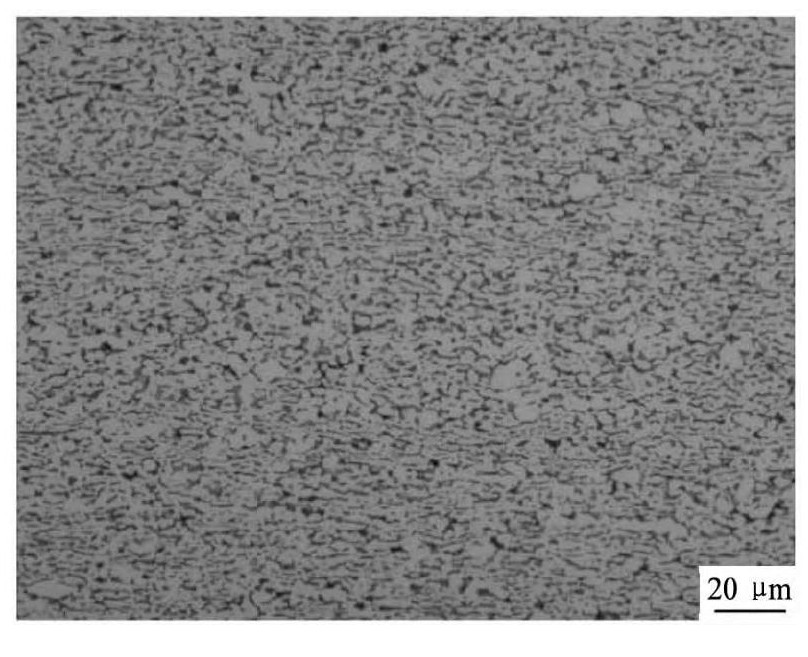网络首发时间: 2013-12-27 15:01
TA15钛合金超塑性变形时的组织演变
西安建筑科技大学冶金工程学院
西北有色金属研究院
西部钛业有限责任公司
摘 要:
研究了TA15钛合金超塑性变形后显微组织的演变及变形条件对超塑性变形行为的影响。结果表明:在变形温度为850950℃、应变速率为1×10-41×10-3s-1超塑性拉伸时, TA15钛合金表现出良好的超塑性变形性能, 且在900℃, 5.5×10-4s-1变形条件下, 延伸率最大为803.3%。在应变速率不变的条件下, 随着变形温度的升高, α相晶粒尺寸增大, β相含量增加, 晶粒仍保持细小、等轴状态。在变形温度一定时, 随着应变速率的降低, α相晶粒尺寸增大, β相含量增加。同时变形程度对显微组织有显著影响, 拉伸后不同部位的显微组织均有一定程度的粗化, 变形程度越大, 晶粒粗化的越明显, 并伴有α相到β相的转变。变形过程中, 加工硬化与变形软化相互竞争, 表现为传统超塑变形的稳态流动特征。
关键词:
中图分类号: TG146.23
作者简介:席兵 (1986-) , 男, 陕西宝鸡人, 硕士研究生, 研究方向:有色金属材料加工;E-mail:zulingxiaoxiao@163.com;;巨建辉, 教授级高级工程师;电话:029-86968630;E-mail:zulingxiaoxiao@163.com;
收稿日期:2013-09-01
基金:陕西省科技统筹创新工程计划项目 (2011KTCG01-17) 资助;
Microstructure Evolution of TA15 Alloy during Superplastic Deformation
Xi Bing Ju Jianhui Wang Jing Shu Ying Wang Ruining Zhang Changjuan
School of Metallurgical Engineering, Xi'an University of Architecture and Technology
Northwest Institute for Nonferrous Metal Research
Western Titanium Technologies Co., Ltd.
Abstract:
The microstructure evolution and the effect of deformation condition during superplastic deformation behavior of TA15 alloy were investigated. The results showed that, from 850 ~ 950 ℃ deformation temperature and 1 × 10- 4~ 1 × 10- 3s- 1strain rate, TA15 alloy had the good superplastic deformation property. Under deformation condition of 900 ℃ and 5. 5 × 10- 4s- 1, it had the biggest elongation of 803. 3%. In the same strain-rate, the dimension of the α phase grains and the content of β phase increased with the tensile temperature increasing, the grains still retained in equiaxed state. At the same deformation temperature, the dimension of the α phase grains and the content of β phase increased with the strain-rate decreasing. Meanwhile, the deformation had a significant influence on the microstructure, different parts of the microstructure had a certain degree of coarsening, greater degree of deformation made coarsening more serious, along with α to β phase transform. During deformation, the hardening and the softening competed against each other, and performed the traditional steady-state superplastic flow characteristics.
Keyword:
TA15 titanium alloy; superplasticity; deformation temperature; strain rate; microstructure;
Received: 2013-09-01
钛及钛合金因其优异的综合性能, 已在航空、航天、石油化工等领域广泛应用[1 - 2]。作为航空理想的关键结构材料, 钛合金超塑成形研究已成为目前钛材料加工的一个热点。然而钛合金在变形时具有变形抗力大、热力参数容差小等特点[3], 变形参数对组织和性能影响较大。
TA15 钛合金具有中等的室温和高温强度、良好的热稳定性和焊接性, 被用于飞机的各种结构件中, 但是大多构件形状复杂, 存在热加工成形困难和成品率低等特点, 严重影响合金的发展及应用。为了解决这一难题, 超塑成形技术成为有效途径。目前对TA15 合金的组织、性能、热处理方面研究较多[4 - 7]。本文在不同变形温度、应变速率条件下超塑拉伸, 研究不同变形条件对TA15 合金超塑拉伸显微组织和变形行为的影响, 为超塑成形的热加工工艺和质量控制提供理论依据。
1 实验
实验采用材料由西部钛业有限责任公司提供的热轧退火态TA15 钛合金 ( Ti-6. 5Al-2Zr-1Mo-1V) 板材, 其显微组织如图1 所示, 化学成分见表1。
超塑性拉伸试验在CMT-4104 型电子万能试验机上进行, 通过程序控制可实现恒应变速率加载方式。设备最大试验力10 k N, 拉伸速度在0. 001 ~500 mm·min- 1之间连续可调, 温度控制采用五段加热控制方式, 温度误差 ± 2 ℃。为了防止拉伸过程中试验高温氧化, 变形前对试样涂覆玻璃防氧化涂层。拉伸温度选择850, 900, 950 ℃, 应变速率1 × 10- 4s- 1, 5. 5 × 10- 4s- 1, 1 × 10- 3s- 1。试样拉断后立即水淬以保留高温组织。组织观察及分析在OLYMPUS PMG3 卧式显微镜上进行。符合GB /T3620. 1 中TA15 钛合金的要求。
图1 热轧退火态TA15 钛合金显微组织Fig. 1 OM image of roll-annealed TA15 alloy
表1 TA15 钛合金化学成分 ( %, 质量分数) Table 1Chemical compositions of Ti-6. 5Al-2Zr-1Mo-1V alloy ( %, mass fraction) 下载原图

表1 TA15 钛合金化学成分 ( %, 质量分数) Table 1Chemical compositions of Ti-6. 5Al-2Zr-1Mo-1V alloy ( %, mass fraction)
2 结果与讨论
2. 1 超塑性拉伸行为图2 为TA15 钛合金在应变速率为5. 5 × 10- 4s- 1, 不同温度下超塑拉伸变形的真应力-真应变曲线。由图2 可以看出, 真应力随着变形温度的增大而减小。变形开始, 因位错密度增加, 材料开始硬化, 随着变形程度的增加, 应力增大并达到峰值。随着应变的增加, 在各变形温度条件下, 应力-应变曲线呈现出不同的特征: ( 1) 在低温 ( 850 ℃) , 应力很快达到峰值后开始降低, 在变形后期应变软化占主导, 表现为加工软化特征; ( 2) 在高温 ( 900, 950 ℃) , 应力逐渐增加到达峰值, 在此过程中加工硬化和软化相互竞争并基本平衡, 表现出传统超塑变行的稳态流动特征。
图3 为TA15 钛合金在900 ℃, 不同应变速率下超塑拉伸变形的真应力-真应变曲线。可以看出, 变形初期, 流动应力随着应变速率的降低而逐渐减少, 在应变速率为1 × 10- 3s- 1时, 最大流动应力为30 MPa; 在1 × 10- 4s- 1时, 最大流动应力仅为15MPa左右。此时加工硬化起主导地位, 导致塑性增加。随着变形程度的增加, 在变形后期, 应变速率为5. 5 × 10- 4s- 1时流动应力最大, 为37 MPa。这是因为在900 ℃, 5. 5 × 10- 4s- 1下超塑拉伸, 组织均匀细小、且 α 相与 β 相含量基本一致, 有效阻碍晶粒长大, 表现出良好的超塑性能, 延伸率达803. 3%[8 - 9]。
图2 TA15 钛合金在不同温度下超塑拉伸真应力-真应变曲线Fig. 2 True stress-true strain curves of TA15 alloy during su-perplastic tensile tests on different temperatures
图3 TA15 钛合金在不同应变速率下超塑拉伸真应力-真应变曲线Fig. 3 True stress-true strain curves of TA15 alloy during su-perplastic tensile tests on different strain rates
2. 2变形条件对TA15 钛合金超塑性拉伸显微组织的影响超塑性变形是金属材料在一定条件所表现的综合力学性能。影响超塑性行为的因素很多, 包括材料本身、变形条件和变形机制, 具体有化学成分、显微组织、晶粒尺寸、晶粒分布、变形温度、应变速率、组织状态、形变硬化、形变软化、晶粒形状及分布、内应力等[10]。这些因素都直接或间接影响超塑性变形的能力和应变速率敏感性指数m值的变化。一般而言, 超塑性的实现要求材料具有微细的等轴组织, 且在变形过程中保持细小和稳定。由于超塑性变形在高温下进行, 因此变形条件会对组织形态 ( 晶粒大小、形状、比例、分布等) 产生影响[11]。为了更好的研究变形过程中组织形态对超塑性变形行为的影响, 对其研究显得至关重要。
变形温度对显微组织的影响: 超塑性变形是在一定温度区间所表现的行为, 选择合适的变形温度有利于材料的超塑成形。图4 为TA15 钛合金在不同温度, 以初始应变速率5. 5 × 10- 4s- 1拉伸后试样断口领域的显微组织。从图4 可以看出, 在850 ~ 950 ℃ 温度范围内, 试样断口领域与拉伸前 ( 图1) 的晶粒相比有所长大, 超塑高温拉伸后组织更加均匀, 且等轴排列。随着温度的升高、变形量的增大, 致使 α 相再结晶后有所长大。这是因为试样在高温下停留时间延长, 聚集了使 α 相和已动态再结晶成核的新晶粒长大所需的能量, 原子的动能增加, 因而位错活动性提高, 扩散蠕变和晶间滑移作用增强[12 - 13]。
对照图4, 在900, 950 ℃ 时, α 相含量减少, 所占比例约为50% , 35% , 这是因为在相变点990℃ 附近随着温度的升高, 变形过程中发生了 α→β的相变。在900 ℃ 变形过程中相变的发生使得 α相和 β 相的含量逐渐趋于接近, 能相互阻止其长大, 故两相较为细小, 塑性较高。
应变速率对显微组织影响: 在900 ℃时, 不同初始应变速率对TA15 钛合金拉伸试样断口的显微组织如图5 所示, 可以看出, 应变速率对合金微观组织中初生 α 相的含量和形貌均有显著影响。在相同的温度下较快速变形时, 试样在高温下停留的时间较短, 初生 α 相相对均匀细小, 含量较高 ( 图5 ( b) , ( c) ) , 这可能是由于在较高初始应变速率下拉伸时具有较高的流变应力, 应力的提高促进了动态再结晶的发生, 使晶粒得以细化。初始应变速率降低至1 × 10- 4s- 1时, α 相明显聚集长大, 且等轴化程度越高 ( 图5 ( a) ) , 这可能是由于塑性变形时初生 α 相晶粒被拉长, 而过于缓慢的拉伸速度, 使试样在长时间的高温变形中, 发生了晶粒的集聚再结晶, 使得 α 相晶粒合并长大。
图4 应变速率5. 5 × 10- 4s- 1, 不同温度TA15 钛合金的显微组织Fig. 4 OM images of TA15 alloy after 5. 5 × 10- 4s- 1strain rate at different temperatures
(a) 850℃; (b) 900℃; (c) 950℃
对照图5, 在低应变速率条件下变形时 ( 图5 ( a) , ( b) ) , 合金有充分的时间进行 α→β 相转变和动态回复及再结晶, 扩散蠕变因此能充分进行, 合金的流动应力很小, 有利于均匀变形。在高应变速率条件下 ( 图5 ( c) ) , 位错密度增加很快, 引起位错塞积, 扩散蠕变和位错滑移不能有效地协调晶界滑动, 导致晶粒在滑动和转动过程中必然在一些地方受阻, 引起应力集中。此时, 材料内部变形的协调过程来不及进行, 应变硬化不能充分消除, 应力集中得不到及时松弛, 不利于均匀变形, 塑性较差。
变形程度对显微组织影响: 为研究不同变形程度对显微组织的影响, 对拉伸后试样进行分析。认为在试样不同部位, 断面大小不同, 表现不同的变形程度。分别在超塑拉伸后试样的夹头部位、中间部位和断口处取样进行组织分析[14]。
图6, 7 为试样在950 ℃ 不同应变速率条件下拉伸的显微组织。可以看出, 随着应变速率的增加, 合金的晶粒逐渐细化, 并伴随着 α→β 相的转变, 这与前面应变速率对显微组织的影响讨论一致。在应变速率1 × 10- 3s- 1时 ( 图6) , 随着变形程度的增加 α 相减少, β 相增多, 表明变形程度也会影响相的转变。在低的应变速率下 ( 图7) , 断口附近显微组织中大部分晶粒已经合并长大, 同时仍可看到动态再结晶形成的等轴小晶粒, 主要是因为在超塑性变形过程中初始应变速率的降低, 新的等轴晶粒不断形成, 但是又不断地被较大的晶粒吞噬合并长大, 发生了聚集再结晶长大现象[15]。研究发现[16], 在Zn-Al共析合金或其他传统超塑性合金中, 试样变形部位的晶粒往往比夹头部分的晶粒大1.7倍或更多, 这表明晶粒长大不单纯是加热的结果, 还与变形有关。对同一个试样, 变形量不同处的晶粒大小不同, 断口处由于变形量最大, 晶粒粗化最为显著 (如图6 (c) , 图7 (c) ) 。
图5 变形温度900 ℃ , 不同应变速率TA15 钛合金的显微组织Fig. 5 OM images of TA15 alloy after 900 ℃ , different strain rates
(a) 1×10-4s-1; (b) 5.5×10-4s-1; (c) 1×10-3s-1
图6 950 ℃ , 1 × 10- 3s- 1下TA15 钛合金拉伸后的显微组织Fig. 6 OM images of TA15 alloy on 950 ℃ , 1 × 10- 3s- 1
(a) Substrate part of specimen; (b) Middle part of specimen; (c) Fracture part of specimen
图 7 950 ℃ ,1 × 10- 4s- 1下 TA15 钛合金拉伸后的显微组织Fig. 7 OM images of TA15 alloy on 950 ℃ ,1 × 10- 4s- 1
( a) Substrate part of specimen; ( b) Middle part of specimen; ( c) Fracture part of specimen
3结论
1.细晶TA15钛合金在850~900℃、应变速率为1×10-4~1×10-3s-1具有良好的超塑性变形行为, 在900℃初始应变速率为5.5×10-4s-1条件下, 最大延伸率达803.3%。
2.在超塑性变形过程中, 随变形程度的增加, 加工硬化与变形软化相互竞争, 表现为传统超塑变形的稳态流动特征。
3.在初始应变速率不变的条件下, 随变形温度的升高, α相晶粒尺寸增大, β相增加, 且在850~950℃温度下, 晶粒仍保持细小、等轴状态;在变形温度不变时, 随着应变速率的降低, α相晶粒尺寸增大, β相增加。
4.超塑性变形后, 变形程度对显微组织有显著的影响。不同部位的显微组织均有一定程度的粗化, 变形程度越大, 晶粒粗化的越明显, 且伴有α相到β相的转变。
参考文献









